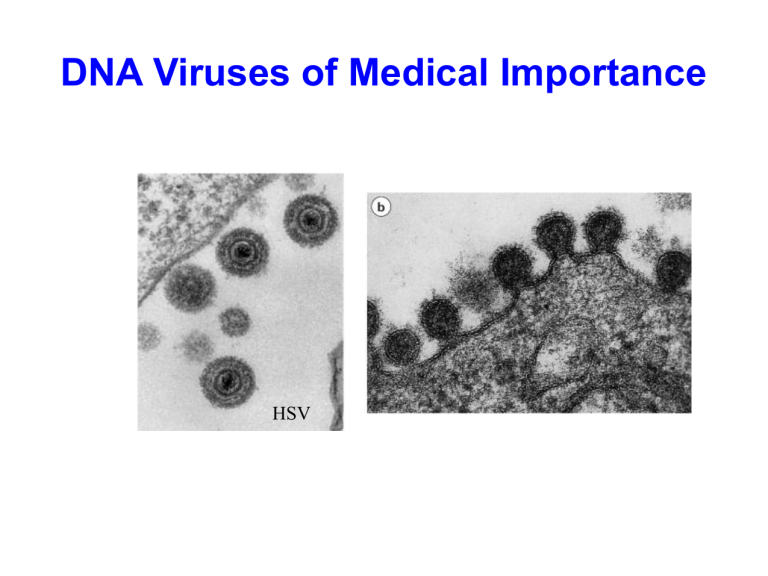
DNA Viruses of Medical Importance HSV Lecture 23 Introduction Enveloped DNA Viruses Poxviruses Naked DNA Viruses Adenoviruses Variola Virus Molloscum Contagiosum Herpesviruses HSV 1 & 2 Varicella-Zoster Virus Epstein-Barr Virus Cytomegalovirus HHV 6 & 7 HHV-8 (Kaposi s sarcoma) Serotypes 1-7 Serotypes 40-42 Papillomaviruses HPV Parvoviruses Parvovirus B19 Viral Hepatitis DNA Hepatitis B Virus (HBV) RNA HAV, HCV, HDV, HEV Viruses & Viral Diseases A virus is a small, acellular, infectious particle. A virus is also an obligate intracellular parasite. Viruses are limited to a particular host or cell type. Viral infections range from very mild to life-threatening. Many viruses are strictly human in origin, others require transmission by zoonotic vectors. Most DNA and a few RNA viruses can become permanent residents of the host cell. - Latent infections - Chronic infections - Oncogenic Several viruses can cross the placenta and cause congenital defects. Certain viruses are also considered teratogens agents that cause birth defects or kill the embryo outright. DNA Viruses Poxviruses Largest and most complex animal virus family Enveloped with a large, brick-shaped appearance Possess dsDNA and have the largest genome of all viruses They multiply in the cytoplasm in well-defined sites called factory areas (carry own polymerases) Produce eruptive skin pustules called pocks or pox, which leave small, depressed scars (pockmarks) upon healing. Important members of the Poxvirus family include: Variola virus causes Smallpox Vaccinia virus used to make Variola vaccine Cowpox virus used in Jenner s ork Monkeypox virus can infect humans Variola virus & Smallpox At one time, smallpox was ranked as one of the deadliest infectious diseases, leaving no civilization untouched. Through the efforts of the World Health Organization, it became the first disease to be eliminated by vaccination. The last case of smallpox was seen in 1977. Strictly a human pathogen Transmission was through inhalation or direct skin contact. Infection associated with fever, malaise, severe headache, & a vesicular rash throughout the body Variola major highly virulent, caused toxemia, shock, and intravascular coagulation Variola minor less virulent Molluscum Contagiosum Caused by the Molluscum Contagiosum Virus (MCV) which forms clusters of benign, pink, waxy, tumorlike growths on skin Transmitted by direct contact and fomites In the U.S., it is most common in children 1-10 years of age and is considered an STD in adults DNA Viruses Herpesviruses Large, enveloped, icosahedral dsDNA virus Named for the tendency of some herpes infections to produce a rash that spreads (creeps). All members show latency and cause recurrent infections. Infections become more severe with age, cancer chemotherapy, immunosuppression, etc. Comprises a large family with 8 known to infect humans: - HHV 1 & 2: Herpes Simplex Virus 1 & 2 (HSV 1 & 2) - HHV-3: Varicella-Zoster Virus (VZV) - HHV-4: Epstein-Barr Virus (EBV) - HHV-5: Cytomegalovirus (CMV) - HHV-6 & HHV-7 - HHV-8: Kaposi s Sarcoma-associated Herpes Virus (KSHV) HSV 1 & 2 Varicella-Zoster Virus (VZV) Etiological agent of Varicella (commonly known as Chickenpox) and a recurrent infection called Herpes Zoster (Shingles). Extremely communicable and transmitted mainly via respiratory droplets but also skin contact. The virus replicates in the respiratory mucosa (incubation of 10-20 days) and then travels through the bloodstream and spreads throughout the body. Primary Infection Chickenpox - Fever and a vesicular itchy rash - Virus enters neurons (dorsal root ganglia) and remains latent A live, attenuated Varicella vaccine is available. Varicella-Zoster Virus (VZV) Secondary infection Shingles Reactivation of the virus results in Herpes Zoster (Shingles) with vesicles localized to distinctive areas Reactivation by such stimuli as X-Ray treatments, immunosuppresive and other drug therapy, surgery, stress Very painful and tender Can cause Chicken Pox in newly infected individuals Epstein-Barr Virus (EBV) Causes the disease known as Infectious Mononucleosis ( the kissing disease ) Transmission: direct oral contact and contamination with saliva Infects lymphoid tissue and salivary glands Very ubiquitous in people. By mid-life, 90-95% of all people have been infected. In some people, the entire course of infection and latency is asymptomatic In children and young adults mononucleosis causes sore throat, high fever, and cervical lymphadenopathy Epstein-Barr Virus and Cancer EBV has been implicated in B rki s lymphoma, a B-cell cancer that usually develops in the jaw and grossly swells the cheek. The prevalence in Africa may be associated with chronic coinfections with other diseases, such as malaria. EBV also has oncogenic implications in nasopharyngeal carcinoma in older Chinese and African men. Cytomegalovirus (CMV) Produces giant cells with nuclear & cytoplasmic inclusions called o ls e e Very ubiquitous human pathogen Transmitted in saliva, respiratory mucus, breast milk, urine, semen, cervical secretions & feces. Can cross the placenta and is the most common cause of congenital infection in the U.S (causing mental retardation and hearing loss). CMV is commonly carried in a latent state in various tissues. Most infections are asymptomatic but can cause cytomegalovirus mononucleosis similar to EBV. Groups that may develop a more virulent form of the disease include newborns and AIDS patients who can develop fever, severe diarrhea, hepatitis, pneumonia, blindness and death. Human Herpes Virus 6 & 7 The most common herpesvirus, with up to 95% prevalence in tested human populations. Transmitted by close contact with saliva and other secretions and targets T cells. Etiological agent of Roseola, an acute febrile disease in babies between 2 and 12 months of age. Illness begins with fever followed by a faint rose pink rash over the neck, trunk, and buttocks. The disease is self-limited and children recover in 2-4 days. Adults may get mono-like symptoms, lymphadenopathy and hepatitis Linked to Multiple Sclerosis, encephalitis, and cancer Kaposi s Sarcoma-associated Herpes Virus (HHV-8) An STD that infects B cells Has been isolated from Kaposi s sarcoma, a common tumor in AIDS patients. DNA Viruses Adenoviruses Non-enveloped (naked) virus icosahedral capsid, dsDNA 30 types are associated with human disease Infect lymphoid tissue, respiratory & intestinal epithelia and conjunctiva of the eye 2 major serotype groups: Serotypes 1-7 (Respiratory) Serotypes 40-42 (Gastroenteritis) - Spread by respiratory droplets and ocular secretions - Spread through fecal-oral route - Cause colds, pharyngitis, viral conjunctivitis - Causes acute watery diarrhea Papillomaviruses Non-enveloped, icosahedral capsid, dsDNA Cause Papillomas (Warts) epithelial growth benign squamous Over 100 different strains of the Human Papillomavirus (HPV) Transmissible through direct contact, contaminated fomites, or autoinoculation Incubation: 2 weeks to more than a year Plantar Warts Common Warts Periungual Warts HPV and Genital Warts Most common STD in the U.S. In excess of 30 million carriers of 35 types of HPV associated with genital warts (most common types are 6, 11, 16, and 18) HPV 16 and 18 cause an estimated 70% of cervical cancer and most HPV-caused anal, vulval, vaginal and penile cancer. Treatment of Warts: - Most common warts regress over time - Physical removal via topical medication, cauterization, freezing, or laser surgery Two effective subunit HPV vaccines are available Cervarix (16, 18) and Gardasil 9 Parvoviruses Very small, non-enveloped, icosahedral virus The only single stranded DNA virus Cause distemper in cats, enteric disease in dogs, fatal cardiac infection in puppies Parvovirus B19 causes infection in human - Disease is called erythema infectiosum or Fifth Disease - Common childhood infection spread by respiratory droplets - Infection may go unnoticed, though the child may have a low-grade fever, a characteristic Slapped Cheek Rash , along ith bod rash. - Severe fatal anemia can result if pregnant woman transmits virus to fetus (hydrops fetalis) DNA Viruses Viral Hepatitis Hepatitis an inflammatory disease of liver cells that may result from several viruses Interferes ith liver s e cretion of bile pigments such as bilirubin into the intestines. Bilirubin accumulates in blood & tissues causing jaundice, a yellowing of the skin and eyes. Caused by several unrelated viruses Hepatitis Viruses Now Includes Hepatitis D (HDV) and Hepatitis E (HEV) Major Hepatitis Viruses HAV HBV HCV HDV HEV Nucleic Acid RNA DNA RNA RNA RNA Naked or Enveloped Naked Enveloped Enveloped Enveloped Naked Transmission FecalOral Bodily Fluids Bodily Fluids Bodily Fluids FecalOral Symptoms Fever, Diarrhea Fever, Rash, Arthritis Fever, Rash, Arthritis Infectious only with HBV Fever, Diarrhea Chronicity No Yes Yes Yes No Vaccine Yes Yes No No No Hepatitis B Virus (HBV) Enveloped, icosahedral, dsDNA Tropism for Liver A minute amount of blood can transmit infection and also spread through sex, semen, saliva, IV drug use, childbirth and breast-feeding Can become a chronic infection Increases risk of cirrhosis and hepatocellular carcinoma



